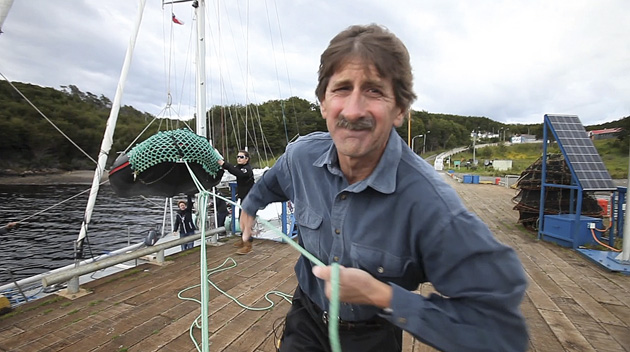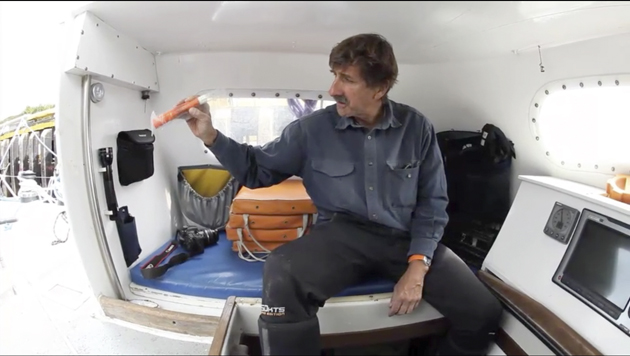Skip Novak shows how to prepare your deck meticulously for a trouble-free and safe passage in stormy conditions
The axiom is that anytime you go offshore you should assume that you will encounter storm sailing conditions. After all, you are on the open ocean and, although weather forecasting has become much more reliable, things can still go awry for one reason or another.
Assuming that immediately after your last voyage you went aloft and did a complete rig check – necessary then as, if there is a problem, discovering it later would delay or scupper your departure – preparing the deck meticulously is an essential routine that makes for a trouble-free and safe passage.
I like to have a deck as clean as is practical, and that means all loose items are taken below and well lashed. That is easier said than done given the interior space available for cruising gear and equipment on most modern yachts with their accommodation pushed well forward leaving virtually no forepeak for bulk stowage. Lazarettes, by design definition, are usually crawl spaces and also minimal.
This is a sad case of yachts being marketed by people who do not sail offshore, and specifically have little idea how much ancillary equipment you actually need to go cruising.
So if you are contemplating a design or build, keep this consideration in mind and realise that berths forward of the mast are quite impractical at sea. Best to factor in some useful space with brackets to stow the heavy and awkward objects.
To me it is absurd to see expensive luxury bluewater cruisers sailing around with jerrycans lashed to the pushpit (as they are usually light on fuel tankage – another subject), hard-body RIBs on the coachroof, hanging from davits or, worse, on the foredeck precariously strapped down, not to mention anchoring gear, spare lines, outboards, dive gear, barbecues and various water toys.
Ship shape
In effect, many yachts look like a boat jumble. It is all well and good to decant this stuff onto the deck once you have arrived at a cruising ground, but offshore these are all liabilities if heavy weather is encountered.
Water is hard when a boat is knocked down and if you are thrown by a breaking sea it can clean the deck of this equipment, most likely taking the lifelines and more with it. We see this quite often down south: boats arriving from the north in a hell of a state, having lost vital equipment that was gobbled up the sea. So assuming you can stow equipment below, best do it.
This might mean trading down your RIB for a soft bottom inflatable that can be stowed below. Davits are fine inshore, but I believe that hanging a dinghy aft makes it vulnerable to a breaking sea from behind.
If you have to stow gear on deck, be excessive with the lashing, though of course that is only as good as the padeyes or other strong points you are lashing to. These must be through-bolted with substantial backing plates.
Having done the obvious, take a walk around from stem to stern. Even if you have checked the rig after the last voyage, do so again at least at deck level. Are all split pins in place? This might mean dismantling shroud covers to lift up the tubes to inspect them properly.
If you have wire rigging and your eyes are beginning to fail, as mine are, use a magnifying glass to look closely at the terminals where the wire disappears into the swage fittings or Norseman/Sta-lok ends. Look for hairline cracks in toggles and rigging screws.
We found that closed shroud rollers don’t allow enough air to circulate around toggles, rigging screws and wire ends, thereby encouraging crevice corrosion in stainless steel. We drilled slots in ours and can lift them at will for inspection.
Seal the chainpipe
If you leave your anchor on the stemhead, which means fixing it in place with a back-up lashing, it is best to lower the chain into the chain locker. Have some system to seal the chainpipe, which for some reason most or all windlass manufacturers fail to provide for.
We made a custom sealing device whereby the end of the chain is attached to the device and let down and later retrieved easily – you can see this in the accompanying video. Even if your chain locker drains overboard, it is quite possible that debris brought up with the chain might, over time, block the drain and if the chainpipe is open you would be sailing around with a chain locker full of water.
Halyard tails at the mast, if not detachable, are another potential problem and if they go over the side they can foul the propeller or rudder. This also goes for sheet and reefing line tails. Throwing them over the top of a winch is not good enough. They must be properly coiled and the tail tied to the standing part of the halyard or a fixed part of the boat – and keep in mind that the ocean has an amazing ability to untie simple knots. As US racer and commentator Gary Jobson once said: “If you can’t tie a good knot, tie lots of them.” Hatches all sealed up? Forepeak hatch dogged down? These seem basic, but a hatch not checked and partly cracked open will at best soak a berth below or at worst be ripped off its hinges.
Even though you had moused every shackle before, probably with plastic cable ties, check them again. Ties will eventually degrade with UV and fall off. Any soft lashings should be checked for wear and chafe. Lifelines must be sound, so again check the terminals and lashings. Any gates in the lifelines or pushpit should be taped up offshore so they cannot open accidentally.
Working aft, check the man overboard gear, making sure it is all in place, attached, clear to deploy and the lights are working. Do an EPIRB test. Jacklines should be verified and all attachment points secure.
Lastly, check lifejackets and their lights, harnesses, flashlights, grab bags and other safety equipment. In an ideal world, they should be stowed near the main companionway or in the doghouse, readily accessible. There is little point in having this essential equipment hidden away. Testing all running lights, mast lights and floodlights the night before departure is also necessary; it is easier to change a bulb there than offshore.
With water tanks topped up and fuel at its top mark, you are now ready to go, relatively secure in the knowledge you are as prepared as you can be.
Offshore checklist
- Rigging OK at deck level
- Shackles moused
- Anchor gear secure
- Hatches secure
- Lifelines and gates fully closed
- Halyard tails tied in
- Jacklines sound
- Safety equipment MOB, EPIRB, PFDs and harnesses all serviced and working
- Running and deck lights working
Part 7: heavy weather sail design
For serious world cruising, meeting heavy weather at some point is a given, robustness of equipment is paramount. This is certainly the case for sails. The choice of material is a crucial factor
12-part series in association with Pantaenius








